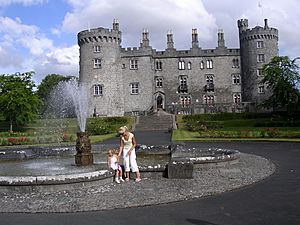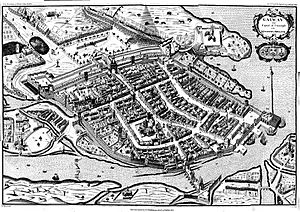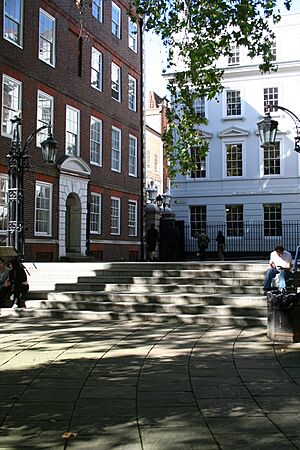Patrick D'Arcy facts for kids
Patrick D'Arcy (1598–1668) was an important Irish lawyer and politician. He was a Catholic who helped lead the Confederate Ireland movement. D'Arcy is best known for writing the constitution for Confederate Ireland. This document aimed to protect the rights of Catholics in Ireland.
Contents
Early Life and Family
Patrick D'Arcy was born in County Galway, Ireland, in 1598. He was the youngest son of James Riabhach D'Arcy. His father was a well-known figure who had been the vice-president of Connacht. He also served as the Mayor of Galway before he died in 1603. Patrick's mother was Elizabeth Martyn. Her family was also quite influential. Patrick's cousin, Richard Martyn, later became his brother-in-law and worked with him as a lawyer.
Patrick likely went to school in Galway when he was young. He later moved to London to study law. In 1617, he became a student at the Middle Temple, a famous law school.
Becoming a Lawyer
D'Arcy studied law for about five years in London. He started working as a lawyer around 1622. One of his first important clients was Richard Burke, the Earl of Clanricarde. The Earl was a very powerful landowner in the Connacht region. D'Arcy's stepfather, Sir Henry Lynch, 1st Baronet, also worked for the Earl.
In 1628, D'Arcy was allowed to practice law in Ireland. This was good news for Catholic lawyers like him. Before, they had to take an "Oath of Supremacy" that went against their beliefs. But a new rule allowed them to take a simpler "Oath of Allegiance" instead. This meant they could now work freely as lawyers.
Fighting for Rights
During this time, King Charles I needed money. He tried to get it by selling land in Ireland. He also questioned the legal ownership of land that Irish people already had. This made many Irish landowners worried.
Patrick D'Arcy became involved in politics to protect the rights of Irish Catholics. He and other leaders, like the Earl of Clanricarde, wanted to ensure Catholics had a voice. They felt threatened by the Protestant government in Dublin. They also worried about their lands being taken away.
In 1634, D'Arcy was elected to the Irish Parliament. He represented the town of Navan. The King's representative, Thomas Wentworth, 1st Earl of Strafford, wanted to take more land. He made sure that juries were mostly Protestant. This made it easier for him to claim Irish lands for the King.
However, a jury in Galway bravely voted against the King's claim. Because of this, the jury members were put in prison. D'Arcy was fined a lot of money (£1,000). He and Richard Martyn traveled to London to complain to the King. But their efforts failed. D'Arcy and Martyn were also disbarred, meaning they could no longer practice law. D'Arcy's brother, who was the head of the Galway jury, even died in prison.
Despite these difficulties, the plan to take land in Connacht did not go ahead. Wentworth, the King's representative, was eventually called back to England. D'Arcy was re-elected to Parliament in 1641. This is when he became even more famous.
D'Arcy's Famous Argument
In 1641, Patrick D'Arcy gave a very important speech in Dublin. This speech was later published as a book called Argument. It was a powerful statement about the rule of law in Ireland. D'Arcy argued that only the Irish Parliament should make laws for Ireland. He believed Ireland should be governed by its own laws, not by unfair decisions from judges or royal officials.
An American expert on constitutions, C.H. McIlwain, said that D'Arcy's Argument was very important. He said it was the first clear statement of ideas that would later be used in America. These ideas were about a country's right to govern itself.
In his book, D'Arcy asked if the people of Ireland were "a free people." He answered that they should be governed only by English common law and laws made by the Irish Parliament. He also said they should follow the lawful customs of Ireland.
Confederate Ireland (1642–1649)

In 1641, a big rebellion broke out in Ireland. This led to Irish Catholics, including the "Old English" families like D'Arcy's, joining together. D'Arcy returned to Galway in 1642. He and Richard Martyn helped lead a "Council of Eight" to manage the town. They worked to get weapons and supplies for defense.
D'Arcy attended a big meeting of Irish Catholics in Kilkenny in October 1642. This group formed the Irish Catholic Confederation. D'Arcy was key in writing their constitution. This document set out how their government would work. He was also one of the twelve members of the Supreme Council, which was the main governing body.
The Confederation wanted to protect Catholic interests. They were loyal to the King and hoped to make a fair peace agreement with him. However, the ongoing civil war and strong disagreements made it very hard to achieve peace.
In 1649, Oliver Cromwell and his army arrived in Ireland. This led to the defeat of the Confederation. Galway surrendered in 1652.
Later Life
After the war, D'Arcy was seen as an enemy by the new government. He was put in jail in Dublin in 1653. His lands were taken away, and he was not allowed to practice law because he was Catholic.
However, when the King returned to power in 1660 (this was called the Restoration), D'Arcy was able to work as a lawyer again. Sadly, his lands were not given back to him.
Patrick D'Arcy died in Dublin in 1668. He was buried in Kilconnell Abbey. His tomb has an inscription that means: "Here, wretched country, lies your sole support." This shows how important people thought he was to Ireland.
Personal Life
In 1628, Patrick D'Arcy married Mary French. She came from an important family. Mary had been married before. Patrick and Mary had a son named James. James later had to leave Ireland in 1650. His descendants included Count Patrick d'Arcy and John D'Arcy, who founded the town of Clifden.




